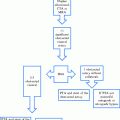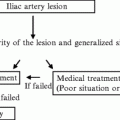Puncture site
Approach
Arteries that can be interrogated
Discussion
Femoral
Retrograde
Aorta and its branches
This is the most common access and can be used to access any arterial bed from the coronary and cerebral to the tibials
Femoral
Antegrade
Ipsilateral infrainguinal
Best approach for a distal tibial or pedal intervention, usually not required for diagnostic angiography. Contraindicated when there is inflow disease or the patient is obese
Brachial/radial
Retrograde
Aorta and its branches including coronary and cerebral arteries
Any vascular bed can be visualized, but it can be a challenge to perform tibial and pedal angiography because of the long distance involved. Brachial puncture has a slightly higher risk
2.
Femoral—This is the most common and versatile access site. Access can be either retrograde (pointed superiorly toward the aortic bifurcation and against the direction of flow) or antegrade (pointed inferiorly toward the foot and in the direction of flow).
(a)
Landmarks—Identify the inguinal ligament (running between the anterior superior iliac spine and pubic tubercle). Optimal CFA access is 1–2 cm inferior to the inguinal ligament. Caution should be used when using the groin crease as a landmark as this is often displaced distally, especially in obese patients.
(b)
Fluoroscopy—Identify the femoral head. The CFA usually passes over the medial portion of the femoral head inferior to the inguinal ligament and is the area where arterial access should be obtained. Puncturing the artery proximal to the femoral head is too proximal and will likely result in access of the external iliac increasing the risk of retroperitoneal hematoma.
(c)
Palpate—Pin the artery between the index and middle fingers of your nondominant hand and use the dominant hand to pass the needle. Ultrasound guidance may be utilized to confirm the relationship to the profunda femoris and inguinal ligament.
(d)
Technique—The angle of approach is typically 45o or steeper. Only the anterior wall of the artery is punctured and a guidewire passed once pulsatile return is obtained. Once wire access is obtained, confirm the position with fluoroscopy, remove the access needle, and introduce the access sheath/dilator over the wire. Flush the side port of the sheath after aspirating until return of blood in the syringe to remove air.
3.
Brachial—This is an alternate choice of access for patients with unfavorable femoral anatomy or previous femoral bypass procedures. The left arm is preferred because right arm access results in crossing both carotid artery ostia increasing the risk of stroke. Brachial access provides for easier access of down-sloping mesenteric vessels. Treatment of lesions distal to the superficial femoral artery is limited due to the distance traversed and the lengths of available sheaths, catheters, and balloons.
(a)
Landmarks—The brachial artery is usually superficial and easily palpable along the medial arm proximal to the antecubital fossa.
(b)
Technique—A steeper angle of approach is recommended. Wire access and sheath placement are performed similar to femoral access. Following removal of the sheath, meticulous hemostasis is mandatory. Hematoma at a brachial access site can result in median nerve compression.
(c)
Duplex USG—Provides useful visualization to access the brachial artery.
4.
Radial—This site is typically reserved for diagnostic angiography of cardiac vessels but may also be used for other types of diagnostic angiography.
4 Venography
1.
Venography has largely been replaced by venous duplex in the diagnosis of deep venous thrombosis (DVT). Utility of venography still exists for thrombolytic therapy of acute venous thrombosis as well as to define anatomy for venous bypass or valve reconstruction. Venography is also performed in the evaluation of iliac vein obstruction in preparation for reconstruction and also gonadal vein reflux in pelvic congestion syndrome.
2.
Diagnostic venography consists of ascending and descending studies. Ascending venography requires distal access (distal great saphenous or vein of the dorsum of the foot) with infusion of contrast oriented toward the vena cava. The patient should be placed in 30o–45o




Stay updated, free articles. Join our Telegram channel

Full access? Get Clinical Tree







